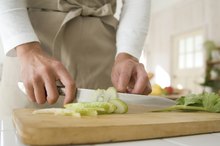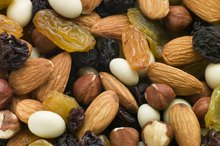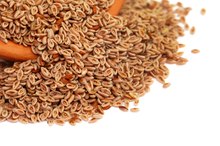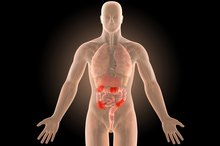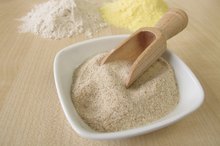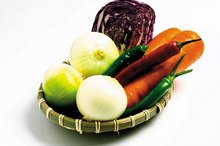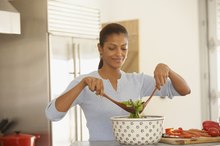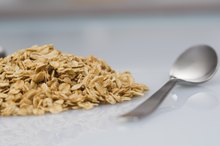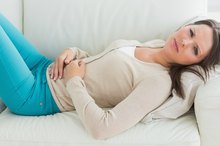What does fact checked mean?
At Healthfully, we strive to deliver objective content that is accurate and up-to-date. Our team periodically reviews articles in order to ensure content quality. The sources cited below consist of evidence from peer-reviewed journals, prominent medical organizations, academic associations, and government data.
The information contained on this site is for informational purposes only, and should not be used as a substitute for the advice of a professional health care provider. Please check with the appropriate physician regarding health questions and concerns. Although we strive to deliver accurate and up-to-date information, no guarantee to that effect is made.
Diet is an important part of the management of diverticulitis or colitis 1. In diverticular disease, small pockets or pouches form in the wall of the colon; when these pouches get inflamed, the condition is called diverticulitis. Colitis is an inflammation of the large intestine; this can be caused by irritable bowel disease, an inflammatory bowel disease like Crohn's, or infections. When you have either of these conditions, you have to make some changes in your diet during the flare-ups to aid in your recovery.
First Stage -- Clear Liquid Diet
Symptoms that can occur with both conditions include fever, abdominal pain, and diarrhea. During this phase of the disease, your doctor may start various medications like antibiotics and put you on a clear liquid diet as well. A clear liquid diet allows your bowel to rest and gives it a chance to heal. You should remain on this diet for 2 to 3 days before you advance to more solid foods.
- Symptoms that can occur with both conditions include fever, abdominal pain, and diarrhea.
- During this phase of the disease, your doctor may start various medications like antibiotics and put you on a clear liquid diet as well.
Second Stage -- Low Fiber Foods
Can You Eat Celery & Blueberries If You Have Diverticulosis?
Learn More
As your condition begins to improve, your doctor will advance your diet to include low fiber foods. A low fiber diet still gives your gastrointestinal tract the opportunity to heal while increasing the nutrients that you consume. Foods that may be part of this diet include:
- canned or cooked fruit
- eggs
- dairy products
- tender cooked meat
- pasta,
- white rice
You should add foods with fiber to your diet gradually as your symptoms improve -- with the guidance of your physician.
Third Stage -- High Fiber Diet
If you have diverticular disease or colitis, you should generally be on a high fiber diet when you are not having a flare-up, according to the University of California San Francisco Medical Center. Fiber can soften your stool, remove toxins, and lower the pressure in your intestine, which may prevent flare-ups. Both insoluble fiber, which is found in whole grains and soluble fiber, which is found in vegetables and fruits are healthy for you. You should add the fiber into your diet slowly because you may experience constipation or gas and bloating; you also have to drink plenty of water to prevent constipation.
- If you have diverticular disease or colitis, you should generally be on a high fiber diet when you are not having a flare-up, according to the University of California San Francisco Medical Center.
- You should add the fiber into your diet slowly because you may experience constipation or gas and bloating; you also have to drink plenty of water to prevent constipation.
Diet Considerations for Diverticular Disease
Do Some Foods Aggravate Diverticulitis?
Learn More
Jackson Siegelbaum Gastroenterology, however, notes that these foods are good sources of fiber and should be included in the diets of diverticulosis patients. You should discuss including these foods in your own diet with your physician.
Diet Considerations for Colitis
Colitis can be caused by several different conditions and each condition might require additional consideration when planning a diet. People with inflammatory bowel disease and irritable bowel syndrome may have to monitor the amount of fiber they consume as it may cause gas and bloating. Since fiber is important to gastrointestinal health and should be a significant part of the stage three diet, you should speak with your physician concerning your level of fiber intake according to your disease. You may also need some supplementation if you are at risk for malnutrition; your physician can help with this as well.
- Colitis can be caused by several different conditions and each condition might require additional consideration when planning a diet.
- You may also need some supplementation if you are at risk for malnutrition; your physician can help with this as well.
Related Articles
References
- MayoClinic.com: Diverticulitis Diet
- Nallapeta NS, Foris LA, Tuma F, et al. Diverticulosis. In: StatPearls. Updated December 13, 2019.
- Carabotti M, Annibale B. Treatment of diverticular disease: an update on latest evidence and clinical implications. DIC. 2018;7:1-11. doi:10.7573/dic.212526
- University of California, San Francisco Health. Diverticular disease and diet.
- American Society of Colon and Rectal Surgeons. Diverticular disease expanded version.
- Rezapour M, Ali S, Stollman N. Diverticular disease: An update on pathogenesis and management. Gut Liver. 2018;12(2):125-132. doi:10.5009/gnl16552
- Strate LL, Keeley BR, Cao Y, Wu K, Giovannucci EL, Chan AT. Western dietary pattern increases, and prudent dietary pattern decreases, risk of incident diverticulitis in a prospective cohort study. Gastroenterology. 2017;152(5):1023-1030.e2. doi:10.1053/j.gastro.2016.12.038
- Dahl C, Crichton M, Jenkins J, et al. Evidence for dietary fibre modification in the recovery and prevention of reoccurrence of acute, uncomplicated diverticulitis: A systematic literature review. Nutrients. 2018; 10(2):137-. doi:10.3390/nu10020137
- Eglash A, Lane CH. What is the most beneficial diet for patients with diverticulosis? J Fam Pract. 2006 September;55(9):813-814.
- Office of Disease Prevention and Health Promotion. Dietary Guidelines 2015-2020.
- Barroso AO, Quigley EM. Diverticula and diverticulitis: time for a reappraisal. Gastroenterology & Hepatology. 2015;11(10):680-8.
- Strate LL, Morris AM. Epidemiology, pathophysiology, and treatment of diverticulitis. Gastroenterology. 2019;156(5):1282-1298.e1. doi:10.1053/j.gastro.2018.12.033
- Okawa Y, Fukudo S, Sanada H. Specific foods can reduce symptoms of irritable bowel syndrome and functional constipation: a review. BioPsychoSocial Med. 2019;13:10. doi:10.1186/s13030-019-0152-5
- NIH National Institute of Diabetes and Digestive and Kidney Diseases. Eating, diet, & nutrition for diverticular disease. Updated May 2016.
- HealthLink BC. Healthy eating guidelines for people with diverticular disease. Updated April 2019.
- Severi C, Carabotti M, Cicenia A, Pallotta L, Annibale B. Recent advances in understanding and managing diverticulitis. F1000 Res. 2018;7:971-. doi:10.12688/f1000research.14299.1
- Dashti HS, Mogensen KM. Recommending small, frequent meals in the clinical care of adults: a review of the evidence and important considerations. Nutr Clin Pract. 2016;32(3):365-377. doi:10.1177/0884533616662995
- Harvard T.H. Chan. Carbohydrates and blood sugar.
- Today’s Dietician. Fiber & irritable bowel syndrome – strategies for counseling patients. Updated August 2016.
- McRorie, JW. Evidence-based approach to fiber supplements and clinically meaningful health benefits, part 2. Nutrition Today. 2015;50(2):90-97. doi:10.1097/NT.0000000000000089
- Stanford Hospital & Clinics. Low fiber diet for diverticulitis. Updated January 2014.
- Abdullah MMH, Gyles CL, Marinangeli CPF, Carlberg JG, Jones PJH. Dietary fibre intakes and reduction in functional constipation rates among Canadian adults: a cost-of-illness analysis. Food & Nutrition Research. 2017;59(1):28646. doi:10.3402/fnr.v59.28646
- The Oregon Clinic. BRAT diet for nausea, vomiting, or diarrhea.
- Uno Y, Velkinburgh JCv. Logical hypothesis: low FODMAP diet to prevent diverticulitis. WJGPT. 2016;7(4):503-512. doi:10.4292/wjgpt.v7.i4.503
- Harvard Medical School Harvard Health Publishing. Diverticular disease prevention and treatment. Updated February 2011.
- Ünlü C, Daniels L, Vrouenraets B, Boermeester M. A systematic review of high-fibre dietary therapy in diverticular disease. Int J Colorectal Dis. 2011;27(4):419-427. doi:10.1007/s00384-011-1308-3
- Weir SBS, Akhondi H. Bland Diet. In:StatPearls. Updated March 9, 2019.
Resources
Writer Bio
Dominique Brooks has been a medical editor for over 10 years. She has worked in medical education for physicians, nurses and pharmacists as well as consumers. She started writing business articles for Work.com in 2008 and health articles online in 2009. She holds a Master of Business Administration from the University of Alabama and a Doctor of Medicine from Vanderbilt University.
